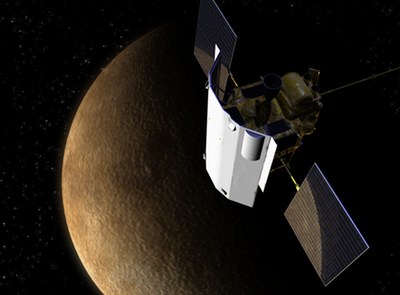In praise of Mercuryby Lou Friedman
|
| My connection and love for Mercury is personal, not scientific. Looking at craters, and counting them, is not my thing. |
Like the Moon, Mercury is also airless. Once its bulk density was determined I became less scientifically interested in it. Density is an important piece of data for modeling the evolution of the solar system. I was deeply involved with early measurements of the mass of Mercury (as part of my Ph.D. thesis) and did a lot of work on the first Mercury mission, Mariner 10, launched in 1973. In fact, on my first day of work at JPL, I was told to go to a Mercury meeting and introduce myself to some guy named Bruce Murray (later to become Director of JPL and co-founder of The Planetary Society with Carl Sagan and me) to work on the trajectory and navigation analysis of Mariner 10.
I soon became great friends with Bepi Columbo, an Italian geophysicist consulting with JPL, and was with him in the meeting of our mission analysis team when he suggested the idea of repeated Mercury flybys being possible with Mariner 10. Mariner 10 was the first mission to use gravity assist for targeting multiple planetary encounters. A whole new theory of astrodynamics was born and opened up the solar system to exploration we never initially dreamed would be possible. It also became my chosen field of work—making missions possible by exploiting the techniques of astrodynamics. That is still an active field of research with applications in cislunar space as well as throughout the solar system.
Thus, my connection and love for Mercury is personal, not scientific. Looking at craters, and counting them, is not my thing. (I once went on a geologic field expedition without ever once picking up a hammer or magnifying glass). But I am in awe that those who do study the detail of the surface features and rocks on planetary bodies can learn so much from them. They’re like the fictional forensic specialists on CSI, Bones, and NCIS, who deduce the stories of the crime from examining clues under a microscope. A recent article on the New Horizons web site describes another example from recent study of Jupiter and Saturn rings showing comet and asteroid impact evidence. I wish the TV folks could make an engaging prime time show about geologists revealing the origin and evolution of the planets and their environments. Not enough dead bodies, I guess. Maybe Mars will provide those in the form of ancient microorganism fossils.
| With MESSENGER now in orbit around Mercury, humanity has now placed spacecraft in orbit around every planet known to the ancients. |
Back to Mercury: This past fortnight MESSENGER became the first Mercury orbiter. It, like Mariner 10, had multiple Mercury flybys on its trajectory through the inner solar system, but with the successful orbit insertion burn on March 17, MESSENGER can now stay there and make detailed observations repeatedly from different vantage points. Kudos to NASA, the Applied Physics Lab team, and to the science team headed by Sean Solomon of the Carnegie Institution! The mission was launched in mid-2004 and has already been operating more than 2,400 days. It has made one Earth, two Venus, and three Mercury flybys on its way to Mercury orbit insertion. In the first three days of mission operations in orbit, MESSENGER took some 1,500 pictures of incredible clarity of the surface of the planet.
I will say this for airless planets: nothing obscures the historical record. Craters within craters, flows, smooth and rough areas—all reveal how the planet has interacted with its solar system environment and has been evolved. We are going to see a lot of comet and asteroid impact history there. MESSENGER will gather a great deal of information about the composition of the planet’s surface. The mission will also observe Mercury’s rather large magnetic field to reveal properties of the planet’s interior as well as how solar radiation impacts the planet’s magnetosphere.
As on the Moon, scientists are interested in seeing into the shadows of the craters near the poles to determine whether ice is present. Such ice would almost certainly derive from comet impacts and could remain frozen in permanently shadowed areas, despite the enormous heat on the sunny side of the planet.
With MESSENGER now in orbit around Mercury, humanity has now placed spacecraft in orbit around every planet known to the ancients (before the invention of the telescope). That’s a milestone in exploration. Our presence at each of these bodies emphasizes the adventure of solar system exploration. I was delighted to see the good media coverage of the Mercury orbiter, even in the midst of the Libyan revolution and the Japanese earthquake crisis. Exploring new worlds is a large part of NASA’s public image—in my view, it is the largest part.
With Stardust NEXT’s flyby of Tempel-1 in February, MESSENGER’s orbit insertion around Mercury, the upcoming Vesta encounter by the Dawn spacecraft, and the ongoing exploration by Opportunity at Mars and Cassini at Saturn, 2011 is a great planetary exploration year. We should enjoy this year of exploration while we can, especially when we consider the gloomy future that Congressional budgets seem to imply for NASA.
